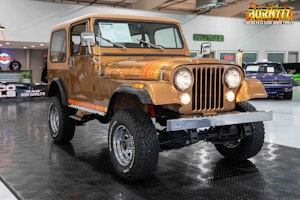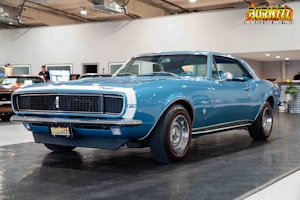Media | Articles
To Make Progress, Sometimes You Need a Distraction
Do I know why my freshly rebuilt Honda XR600R engine doesn’t run? No.
Am I particularly concerned? Also no.
To make matters worse, I spent the few precious hours that could be spared on this particularly busy week to loosely attach the gas tank, side panels, fenders, and headlight. I keep telling myself it was a “mock up,” a chance to check some final clearances and fits before the frame is fully stripped down in preparation for its final finish. This is the last call for the grinder and welder, the perfect time to fit the engine into the frame and break the engine in.
If you watch too much television, you know the worst best time to attempt the initial startup of your high-performance and even higher dollar engine is once it’s in the fully finished project. This way, you ensure that each lean over the fender risks putting a belt-buckle scratch in the fresh paint, and any small leaks that may pop-up can silently conspire to eat away paint or stain raw parts.
Regular readers of this column know that I don’t roll like that. Because starting up and breaking in this XR600R engine was going to involve a few processes that were new to me, like properly priming and checking the dry-sump oiling system, it only made sense for me to put the engine in some kind of run stand to make those procedures as easy as possible.
Marketplace
Buy and sell classics with confidence

My smaller XR250R engines bolt into a simple cradle that I hacked together as a “re-learn to weld” project in 1/8″ steel. Kick-starting an engine in these stands is awkward at best, and the mass of the XR600R’s engine wasn’t going to make things easier. After spending more time than I would care to admit attempting to design my perfect run-in stand, I realized I already had one. Honda had built it for me: The damn frame. Sometimes, you gotta remember to put the tools down.
The big XR600R has only rolled on its own tires twice. Once when it came into this garage, and last Saturday, when I used a cordless drill to wind the scissor jack that, until then, seemed permanently installed under the steel frame. In the a short trip from the red-and-black hydraulic lift over to the garage door, the suspension bore weight for the first time in nearly a year. Once I carefully leaned the bike so that the edge of the handlebar rested against the flat wood door, I walked the six paces across the garage, where my wife’s car would normally be parked, picked up my coffee, re-situated my work stool, and did some staring.



My garage is a decent size, but in the winter, it gets crowded, and it’s easy to lose sight of the actual project I am working on—literally, as well as figuratively. For months, I’ve basically not been able to stand further than 3 to 4 feet away from this bike. When you can never take in the whole thing, every little detail of a project feels huge. This bike is a veritable mountain of small projects that roll up into one.
After installing the engine into the frame, I still had to modify the exhaust to fit before I could try running the engine, and the wire harness is a mess. A functional mess, but one that will need to be dealt with. After the second 45-minute kicking session, I realized I was downright frustrated and began to question what I was doing.


Now that I had spent the next time slot on my calendar performing a very premature and poorly done mock-up of the finished bike, I decided to sit and over-caffeinate myself until where I plan to ride this bike and who I plan to ride it with came back into focus. I was effectively wasting time, considering the amount of stuff I had to do, yet taking a break was the one thing that needed to happen before any of those other decidedly more tactile and measurable tasks could be done to any degree of satisfaction.

Sitting and staring forced me to acknowledge the amount of work I’ve done thus far on the bike, and how much is truly left to do. More than anything, taking a break forced my brain to switch off from the task at hand. The engine isn’t running. The plug is wet after a number of kicks, spark is consistent and hot, the stator is pumping proper voltage to the CDI. The engine should be idling strong, yet it only coughs.
All that’s okay for now. Now that I’ve stepped back and enjoyed the view of the forest that is this motorcycle project, the trees aren’t nearly as intimidating.



















I applaud this step, Kyle. It seems like “wasting time” to some, but it serves a purpose on a large project timeline. It’s similar to an athlete just taking a break from intensive training – giving not only the muscles but the mind to do a reset. Getting in the right place mentally helps us build new focus to continue. And the coffee helps, it does!
As a retired runner that is a great sports analogy to use. Rest works for all parts of the body.
My father taught me this same thing. I’d be working on my car, him lending a hand, until some aggravation would get the best of me. – “Lets take five Junior. Have a cup of tea.”- Quite often the source of my frustration was my own frustration. It’s one thing to loaf ,another to believe if you’re not working you aren’t trying hard enough. So regain your perspective. ‘ Deep cleansing breath’ and then back to it._ Anyone who’s painted knows that some pieces come together easily. As though they have a mind of their own and you’re just an instrument. Others what you see in your head and what is on canvas are two different things. You have to work through that. ” The love of the struggle” as a professor of mine would say. However she also advised if you’re really stuck on something and overthinking it, turn your painting around to the wall and walk away. Go do something else. That was also good advice. What you were missing may become readily apparent upon revisiting – ” the forest though the trees”.
How about an article on how you installed inverted forks? Did you reinforce the frame?
The fork swap is the basic CR/CRF swap for the 600R. Pressed the 600R steering stem into the CRF lower triple, uses 600R steering neck bearings. Only real thing to figure out is how one wants to do the steering stops.
Thus far–and the welder is not put away yet–I have elected not to brace the frame. With no intentions of loading it up for anything more than a one or two night trip it seems that adding metal the the frame is just weight I would carry around 100% of the time that I only need 5% of the time (if that much.) That said, the current black “paint” is some kind of rubberized truck bed liner so I expect to find some surprises when the frame is fully stripped and blasted. That might change my mind on bracing.
If nothing else it sure looks good!
I’ve earned that “they’re done when they’re damn good and ready”…almost as though they want to be sure the builder is worthy, haha. The solution to the problem may well pop into your head at 3 AM to sit upright.
It does feel like this problem is one good nights sleep from a solution. Fingers crossed.
Looking good, it will be running soon!
Kill switch on? Just saying. That’s gotten me more times than I’d like to admit.
That’s part of why I only run momentary kill switches, especially on first start-ups. There is nothing like finding out the kill switch is thwarting all your efforts!
Back to basics kid. Verify the Holy Trinity. If still no self sustaining rotation, question your methods of verification. At some point there’ll be a face-palm moment, which ALL of us have experienced, that you don’t have to admit to us… unless it would make an entertaining column…..!
Ignition timing?